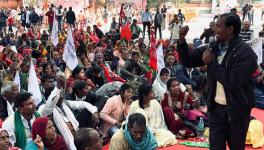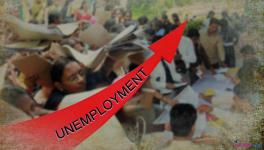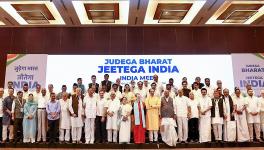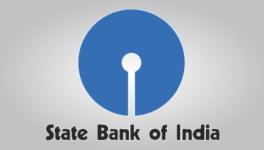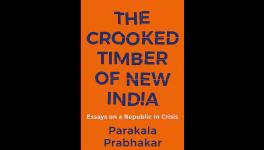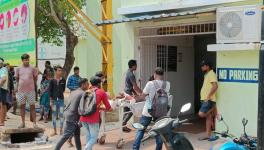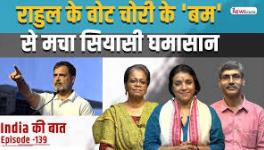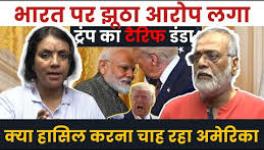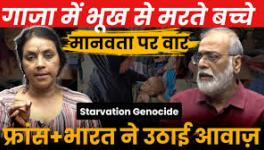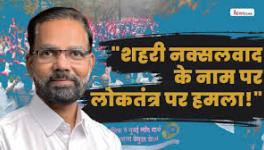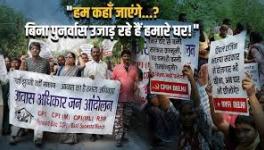Modi Dumping Welfare Schemes & Poll-Eve ‘Guarantees’
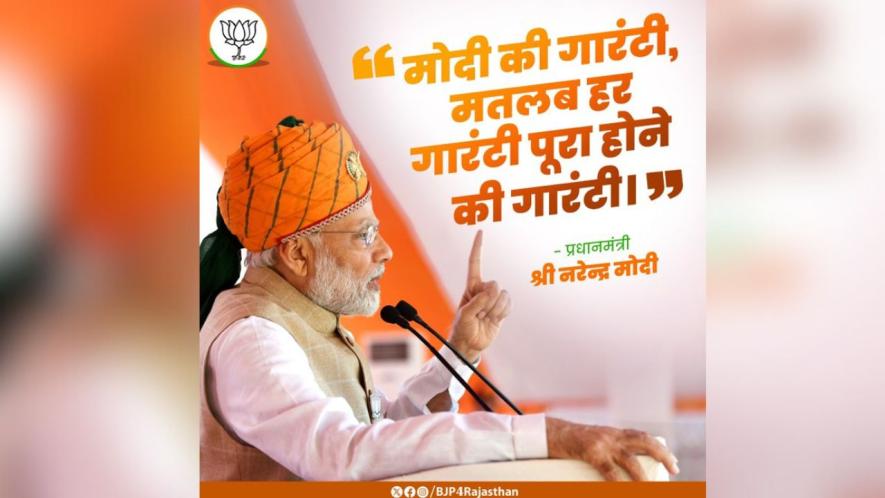
Image Courtesy: Twitter/@BJP4Rajasthan
Prime Minister Narendra Modi’s welfare programmes and flagship schemes, which remained the ruling Bharatiya Janata Party’s (BJP) chief campaign plank for over a decade, are in for an unceremonious burial. Modi’s backroom boys, old reform era economists and BJP’s top two have been considering, for the past two years, on how to get rid of these much-hyped schemes
There was unanimity among the Modi aides that his welfare schemes, most of them were announced impromptu by the Prime Minister in his early years, have turned politically unproductive. Originally, it was hoped that the schemes would enhance Modi’s image as a ‘poor man’s hero’ even while his patronage would give them a special status. Now both have become counter-productive.
The push to abandon the schemes came from both the Finance Ministry and the Finance Commission (FC) — the former due to the growing budget ‘burden.’ The current FC chairman Arvind Panagaria has been an old critic of populist schemes. Party analysts have also noted diminishing returns from some schemes after every election. Instead, poll-eve bonanzas at the state-level are found more cost-effective for luring voters.
The first sign of dumping the schemes came from Modi when he talked about these reaching ‘saturation’ point at the Chief Ministers’ conference two years back. Since then he has been frequently reiterating the point. Last year, he claimed the saturation reflected ‘true secularism and social justice’ whatever it meant.
Modi said ‘appeasement politics’ will come to an end when his welfare schemes reach 100% coverage or saturation point. Finally, in May this year, the Finance Ministry — not the Prime Minister — directed department secretaries that all Centrally- Sponsored Schemes (CSS) and Central Sector Schemes (CS) would be denied funds from 2026 unless they get a third party evaluation done.
Most ‘Modi schemes’, including the flagships, come under CSS or CS. Will he, at the last minute, spare a selected few of his pet schemes from the axe due to their continuing electoral utility? We do not know yet. This is because every welfare scheme since 2014 was ad hoc and wrapped in incongruity.
The Modi schemes got so much publicity but very little hard facts. There is confusion even about the exact number of such schemes, including the CSS and CS. This was best described by the late Bibek Debroy, former head of the PM’s Economic Advisory Council. Quoting the 15th Finance Commission, he said: “Till recently, there seems to be confusion about the number of the existing CSS. The department of expenditure has drawn up a list of 131 CSS.”
Individual ministries have their own figures. The IAS aspirants are fed by the coaching sites with data collected from various sources, including those occasionally revealed in Parliament. There are some private studies but those too do not provide any additional data.
Have the welfare schemes really reached a saturation point, as Modi claims? Paucity of hard data makes it a wild goose chase. With no independent evaluation, all that we have is claims like ‘80 cr poor are getting free ration’, ‘50 cr citizens have joined the banking system,’ ‘34 cr empowered by way of DBT,’ and ‘four crore people given pucca houses.’ (BJP’s 2024 Sankalp Patra or Manifesto).
Breaking through the tight information control and the impregnable data wall, this writer was able to collect and collate real facts about some of the welfare schemes.
MGNREGS: Look at the irony of the PM’s biggest welfare scheme in terms of outlay. While the Rural Development Ministry has sought an increased allocation for the scheme, the Finance Ministry has announced a funding cap of 60% in the budget. And both point to the increasing demand for jobs, not ‘saturation’ point, as claimed by Modi.
Plagued by Aadhar hurdles, wage denials and accumulated wage dues to the workers, MGNREGS are gripped with corruption in at least a dozen states, such as Bihar, Andhra Pradesh, Punjab, Odisha and West Bengal. In Gujarat, a BJP minister and his son were arrested for involvement in a massive Rs. 71 crore MGNREGS scam.
Bullet Train: The Mumbai-Ahmedabad bullet train project was approved by the Modi government soon after taking over in May 2014. In fact, the Memorandum of Understanding for the project was signed by the previous United Progressive Alliance government, not Modi. But despite the Gujarat connection, this prestigious project got delayed due to sheer inefficiency, delays in land acquisition and accidents.
After 2022, the Prime Minister even stopped giving deadlines for the completion of the project. However, the unofficial deadline is 2028, a good14 years after the project began. Meanwhile, delayed deadlines, cost overruns, rising EMIs and lower estimated revenue have made it a big liability to the exchequer. ,
Namami Gange: The Namami Gange scheme, which strikes an emotional chord with Modi and Rashtriya Swayamsevak Sangh or RSS, was launched in 2014 with the aim to clean the entire Ganga in five years. However, Murli Manohar Joshi, BJP’s old guard and a ‘Ganga kinare wala’, curtly warned Modi: “At the present rate, Ganga cannot be cleaned even in 50 years”. How prophetic was the warning.
For 11 years, the Namami Gange project has been languishing due to tardy implementation with just 69% of funds utilised. According to the think-tank PRS Legislative Research, only 52% of targeted 7,000 mld were achieved leading to continued flow of untreated water into Ganga. Similar was the case with sewage treatment. The Public Accounts Committee (2024) flayed the “large expenditure on advertising and promotion (with large Modi portraits) without any proportional impact on the ground.” (Ibid)
Nal se Jal: Launched in 2019, the Jaljivan mission was to provide safe drinking water to every household by 2024. But only half a dozen states and some Union Territories were able to meet the target. About 40 million households are left without water. The scheme also suffers from a sudden drop of 68% in funds allocation and widespread financial irregularities.
PM Kusum: This solar power scheme is another laggard. As per data provided in Parliament, just 2.56% of the 10,000 MW in decentralised solar power target has been achieved during the five years. In the organised sector, however, the government managed to install 7.12 lakh solar pumps or over half out of a targeted 14 lakh. The solar sector is also suffering from higher cost of imported panels and lower domestic production.
Make in India: With domestic investors remaining reluctant and foreign direct investment (FDI) flowing in drips, the PM’s Make in India and Atmanirbhar Bharat initiatives have failed to make any impact. This despite offering better infrastructure, tightening intellectual property rules and a series of concessions to raise the share of manufacturing from 15% of GDP in 2013 to 25%. There was some improvement in sectors like IT, but it was ‘assembling in India’
As the welfare schemes failed to make an impact, the Modi-Amit Shah duo tried another marketing strategy. Thus, the 2024 Lok Sabha polls became an election of ‘Modi’s guarantees.’ At every election rally, he repeated the ‘100%’ guarantee. “I Guarantee 100% benefits to 100% beneficiaries,” he asserted. He said his schemes were 100% ‘secular’.
At the Gaya rally in Bihar, Modi thundered: hereafter the guarantee will be accompanied by a ‘Modi card’. Earlier, he said the BJP manifesto itself was a ‘Modi guarantee card.’ At the Viksit Bharat Yatra, he talked of ‘my guarantee ki gaadi’. However, Nationalist Congress Party veteran Sharad Pawar snapped at Modi: “Modi’s guarantee is all without dates and thus meant little.”
Modi schemes have come in fits and starts to appease different vote banks. Some were unveiled from the ramparts of Red Fort. Another set of schemes were hurriedly drawn up to counter the allegation of being a ‘suit-boot sarkar’ when the government came out with a stimulus package to boost the economy.
Thus came schemes like Garib Kalyan Rozgar Abhiyan, Jal Jivan mission and PM Kisan Samman Nidhi. The first three programmes — Jan Dhan Yojana, Skill India Abhiyan and Make in India — were announced in August 2014, three months after Modi took office.
There are so many bima (insurance) yojanas: Fasal Bima Yojana for farmers, PM Suraksha Yojana for the poor, Jiwan Jyoti Bima Yojana for all. And so many pension schemes for the middle classes and poor. For safe water for the deprived, Modi announced schemes variously called Jal Jivan Mission, Nal se jal and Har Ghar Jal. He offered Ujala or light for all for these who have no LED lights.
The Ujwala scheme was intended to provide free LPG connection for all with cylinders. Before the election in Delhi, he launched the PM Udaya to give ownership rights in unauthorised colonies.
For the aspiring middle classes, Modi offered different kinds of programmes. Digital India to digitalise financial transactions and Start Up Mission to encourage young techies to engage in innovative projects. Then there were schemes like Swachh Bharat Abhiyan and Smart Cities Mission to fire the imagination of the citizens.
The writer is a veteran journalist. The views are personal.
Get the latest reports & analysis with people's perspective on Protests, movements & deep analytical videos, discussions of the current affairs in your Telegram app. Subscribe to NewsClick's Telegram channel & get Real-Time updates on stories, as they get published on our website.











